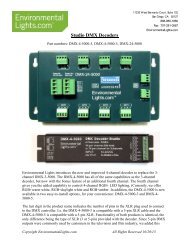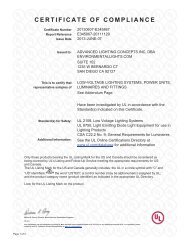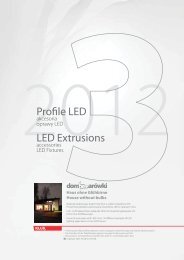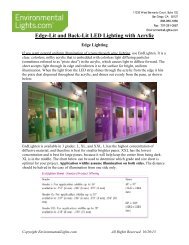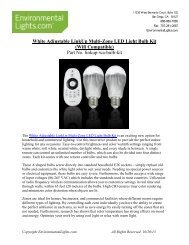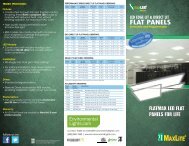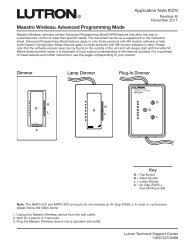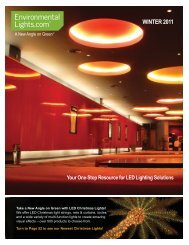Easy Stand Alone (U8) Getting Started Guide - LED Lighting
Easy Stand Alone (U8) Getting Started Guide - LED Lighting
Easy Stand Alone (U8) Getting Started Guide - LED Lighting
You also want an ePaper? Increase the reach of your titles
YUMPU automatically turns print PDFs into web optimized ePapers that Google loves.
11235 West Bernardo Court, Suite 102<br />
San Diego, CA 92127<br />
888-880-1880<br />
Fax: 707-281-0567<br />
EnvironmentalLights.com<br />
Kit Front Back<br />
<strong>Easy</strong> <strong>Stand</strong> <strong>Alone</strong> (<strong>U8</strong>) <strong>Getting</strong> <strong>Started</strong> <strong>Guide</strong><br />
Install "<strong>Easy</strong> <strong>Stand</strong> <strong>Alone</strong>" software with the <strong>Easy</strong> <strong>Stand</strong> <strong>Alone</strong> controller. Do not install Sunlite Suite.<br />
Compatibility<br />
Compatible with Windows 7/Vista/XP (32 or 64 bit for all) and Apple computers running Windows 7/Vista/XP.<br />
Not compatible with Apple operating systems, Windows 98 or other operating systems.<br />
<strong>U8</strong> Improvements Over the U5 Version<br />
The <strong>U8</strong> works with more recent operating systems than the U5. The <strong>U8</strong> also uses a mini USB jack for power, whereas the U5 used a<br />
2.1 mm jack. This obviates the need for a power selector switch on the <strong>U8</strong>. That‟s one fewer thing to think about.<br />
Particulars of the <strong>Easy</strong> <strong>Stand</strong>alone Kit as offered by EnvironmentalLights.com<br />
We always ship the <strong>U8</strong> with the adapter to allow standalone operation. Others don‟t. We also created this getting started guide to help<br />
get you going quickly.<br />
Installing the software on your computer<br />
Insert the CD. Accept licensing agreement. At main menu, select <strong>Easy</strong> <strong>Stand</strong> <strong>Alone</strong> software installation and click the computer icon<br />
at lower left to install software. When you see the left screen below, connect your controller to your computer using the included USB<br />
cable and then click “Finish.” When you see the right screen below, click “Finish.”<br />
Copyright EnvironmentalLights.com All Rights Reserved 12/16/12
<strong>Getting</strong> started<br />
When you click on the <strong>Easy</strong> <strong>Stand</strong> <strong>Alone</strong> icon to start the software, you are given 4 choices for operating mode:<br />
Choose one of the first two: 1) demo mode, if you don‟t want to actually hook up your controller and just want to see the software on<br />
your computer or 2) USB-DMX interface mode, if you‟ve already connected your controller to the computer using the supplied cable.<br />
Also, connect your DMX decoder or DMX driven wall washers or other lights to the controller. It may take a minute or two after you<br />
connect your controller for you to be presented with the option of USB mode. Your computer needs to detect the device first.<br />
The software opens to the “Setup” tab. In the top left “Scan Library” section, expand the first selection (Generic), and find the<br />
corresponding icon to match your “rgb, rgba, rgbw, or rgby” channel <strong>LED</strong> strip lighting below it. Drag the “rgb” icon up and to the<br />
right and drop it onto channels 1, 2 and 3 in the “Patch” panel. Now the red, green and blue sliders appear at the bottom left of your<br />
screen. Similarly, you can instead drag the “rgba, rgbw, or rgby” icon up and to the right and drop it onto channels 1, 2, 3, and 4 in the<br />
“Patch” panel. Now the red, green, blue, and other color (amber, white, or yellow) sliders will appear at the bottom left of your screen.<br />
You can independently dial red, green, blue, and “other color” up and down using the sliders. If you have a wall washer or decoder<br />
and <strong>LED</strong> RGB or RGBX strips connected to your controller and are operating in USB-DMX mode, your lights will respond. (Be sure<br />
the address on your decoder or wall washer is set to 1. That‟s the lowest address, which happens to be red. Green, blue, and “other”<br />
are 2, 3, and 4 respectively. If you have other devices, you can drag additional rgb, rgba, rgbw, or rgby icons up and to the right and<br />
drop them into the next available channels, and so forth.<br />
Click on the “Editor” tab. Set your color sliders where you want them for the first “step” of your program (“Scene.”) Click the green<br />
“plus” sign in the “Steps” section to add steps. You can type the fade time and the wait time for each step. You can also set the global<br />
(red and green and blue) dimming level for each step in the “Steps” section. You can press the green > arrow “Play” button in the<br />
Scenes section to run your program.<br />
Click the “<strong>Stand</strong> <strong>Alone</strong>” tab to write to the controller. If you‟re in USB-DMX mode and your controller is connected, when you click<br />
“Write memory…” you will write to the controller.<br />
Uncheck the „Do not go in “<strong>Stand</strong> <strong>Alone</strong>” now‟ button, and your controller will then be receiving only power (no signal) from your<br />
computer. Disconnect your controller from the computer. Connect the adapter to operate in standalone mode without power from your<br />
computer.<br />
On the controller, the + and – buttons control are used to cycle through the scenes you‟ve programmed. The other button is the<br />
dimming button. Hold it down and press + or – to brighten or dim the lights as they execute your scene.<br />
You may use the 10 pin connector (pin out is on the last page of the manual) on the back to remotely switch to scenes you have<br />
programmed that you select with a Crestron or other switch. This is handy for operating the controller from a custom console you<br />
have, or from the arm rest switch of a limousine, for example.<br />
Those are just the bare basics. You can do much more. The manual is on the CD and on our web site.<br />
Channels: 512<br />
Number of scenes (programs): 255<br />
Number of zones: 1<br />
Copyright EnvironmentalLights.com 2 All Rights Reserved 12/16/12
11235 West Bernardo Court, Suite 102<br />
San Diego, CA 92127<br />
888-880-1880<br />
Fax: 707-281-0567<br />
EnvironmentalLights.com<br />
Circuit Diagrams<br />
Here are some examples of how you can use the <strong>Easy</strong> <strong>Stand</strong> <strong>Alone</strong> DMX Controllers (SLESA-<br />
<strong>U8</strong> or STICK-GU2) to create color-changing systems. Both controllers use the Sunlite<br />
Nicolaudie <strong>Easy</strong> <strong>Stand</strong> <strong>Alone</strong> software for DMX <strong>LED</strong> lighting control.<br />
Small Scale Installation Using <strong>Easy</strong> <strong>Stand</strong> <strong>Alone</strong> DMX Controller (SLESA-<strong>U8</strong> OR STICK-GU2)<br />
<strong>Easy</strong> <strong>Stand</strong> <strong>Alone</strong><br />
DMX Controller<br />
DMX Decoder<br />
RGB strips,<br />
RGB+Other color strips,<br />
DMX (5 wires: red, green, superflat rope,<br />
signal blue, other, or modules<br />
and common)<br />
SLESA-<strong>U8</strong><br />
OR<br />
Stick 2 Sunlite Touch-<br />
Sensitive Intelligent Control<br />
Keypad (DMX Controller)<br />
Do not exceed the product's<br />
specified branch length limit.<br />
DMX-4-5000<br />
Do not exceed the power rating<br />
(2 wires, +V & ground) of the lowest-rated<br />
driver, amp or controller.<br />
12 or 24 VDC Driver<br />
When powering superflat rope, use<br />
24 volt components.<br />
Do not mix 12 and 24 volt systems,<br />
except at the DMX level. (You may<br />
put both 12 and 24 volt decoders on<br />
the same DMX output.)<br />
STICK-GU2<br />
Small Scale Installation Using <strong>Easy</strong> <strong>Stand</strong> <strong>Alone</strong> DMX Controller (SLESA-<strong>U8</strong> OR STICK-GU2)<br />
<strong>Easy</strong> <strong>Stand</strong> <strong>Alone</strong><br />
DMX Controller<br />
DMX Decoder<br />
RGB strip 1<br />
RGB strip 2<br />
DMX RGB strip 3<br />
signal<br />
RGB strip 4<br />
SLESA-<strong>U8</strong><br />
OR<br />
Stick 2 Sunlite Touch-<br />
Sensitive Intelligent Control<br />
Keypad (DMX Controller)<br />
Do not exceed the product's<br />
specified branch length limit.<br />
RGB-DMX-12<br />
Do not exceed the power rating<br />
(2 wires, +V & ground) of the lowest-rated<br />
driver, amp or controller.<br />
12 or 24 VDC Driver<br />
When powering superflat rope, use<br />
24 volt components.<br />
Do not mix 12 and 24 volt systems,<br />
except at the DMX level. (You may<br />
put both 12 and 24 volt decoders on<br />
the same DMX output.)<br />
STICK-GU2<br />
Please call if you need assistance.<br />
Copyright EnvironmentalLights.com All Rights Reserved 12/16/12
Larger Scale Installation Using <strong>Easy</strong> <strong>Stand</strong> <strong>Alone</strong> DMX Controller (SLESA-<strong>U8</strong> OR STICK-GU2)<br />
<strong>Easy</strong> <strong>Stand</strong> <strong>Alone</strong><br />
DMX Controller<br />
DMX Decoder<br />
DMX signal<br />
(5 wires: red, green,<br />
blue, other,<br />
and common)<br />
Do not exceed the product's<br />
specified branch length limit.<br />
SLESA-<strong>U8</strong><br />
OR<br />
Stick 2 Sunlite Touch-<br />
Sensitive Intelligent Control<br />
Keypad (DMX Controller)<br />
DMX-4-5000<br />
Do not exceed the power rating<br />
of the lowest-rated<br />
driver, amp or controller.<br />
When powering superflat rope, use<br />
24 volt components.<br />
Do not mix 12 and 24 volt systems,<br />
MaleMiniPlug<br />
except at the DMX level. (You may<br />
put both 12 and 24 volt decoders on<br />
(2 wires, +12V & ground) the same DMX output.)<br />
12 or 24 VDC Adapter<br />
STICK-GU2<br />
24 watts is adequate<br />
Amp 1<br />
(5 wires: red, green,<br />
blue, other, common)<br />
RGB strips,<br />
RGBColorPlus,<br />
superflat rope,<br />
or modules<br />
AMP4<br />
12 or 24 VDC Driver<br />
(2 wires, +V & ground)<br />
Amp 2<br />
AMP4<br />
(5 wires: red, green,<br />
blue, other, common)<br />
RGB strips,<br />
RGBColorPlus,<br />
superflat rope,<br />
or modules<br />
etc.<br />
12 or 24 VDC Driver<br />
(2 wires, +V & ground)<br />
Copyright EnvironmentalLights.com 2 All Rights Reserved 12/16/12
Larger Scale Installation Using <strong>Easy</strong> <strong>Stand</strong> <strong>Alone</strong> DMX Controller (SLESA-<strong>U8</strong> OR STICK-GU2)<br />
<strong>Easy</strong> <strong>Stand</strong> <strong>Alone</strong><br />
DMX Controller<br />
DMX Decoder<br />
DMX signal<br />
(16 wires: red, green,<br />
blue, and common<br />
x 4)<br />
Do not exceed the product's<br />
specified branch length limit.<br />
SLESA-<strong>U8</strong><br />
OR<br />
Stick 2 Sunlite Touch-<br />
Sensitive Intelligent Control<br />
Keypad (DMX Controller)<br />
RGB-DMX-12<br />
Do not exceed the power rating<br />
of the lowest-rated<br />
driver, amp or controller.<br />
When powering superflat rope, use<br />
24 volt components.<br />
Do not mix 12 and 24 volt systems,<br />
MaleMiniPlug<br />
except at the DMX level. (You may<br />
put both 12 and 24 volt decoders on<br />
(2 wires, +12V & ground) the same DMX output.)<br />
12 or 24 VDC Adapter<br />
STICK-GU2<br />
24 watts is adequate<br />
Amp 1<br />
(4 wires: red, green,<br />
blue, common)<br />
RGB strips,<br />
superflat rope,<br />
or modules<br />
AMP4<br />
12 or 24 VDC Driver<br />
(2 wires, +V & ground)<br />
Amp 2<br />
AMP4<br />
(4 wires: red, green,<br />
blue, common)<br />
RGB strips,<br />
superflat rope,<br />
or modules<br />
etc.<br />
12 or 24 VDC Driver<br />
(2 wires, +V & ground)<br />
Copyright EnvironmentalLights.com 3 All Rights Reserved 12/16/12
<strong>Easy</strong> <strong>Stand</strong> <strong>Alone</strong>
SUNLITE is a trademark of Bruno Nicolaudie.<br />
WINDOWS is a trademark of the MICROSOFT CORPORATION.<br />
All rights reserved. No parts of this work may be reproduced in any form or by any means - graphic, electronic, or<br />
mechanical, including photocopying, recording, taping, or information storage and retrieval systems - without the<br />
written permission of the publisher.<br />
Products that are referred to in this document may be either trademarks and/or registered trademarks of the<br />
respective owners. The publisher and the author make no claim to these trademarks.<br />
While every precaution has been taken in the preparation of this document, the publisher and the author assume<br />
no responsibility for errors or omissions, or for damages resulting from the use of information contained in this<br />
document or from the use of programs and source code that may accompany it. In no event shall the publisher<br />
and the author be liable for any loss of profit or any other commercial damage caused or alleged to have been<br />
caused directly or indirectly by this document.<br />
© 1989-2009 Nicolaudie
Table of contents<br />
I Overview 1<br />
II Contents and installation 3<br />
1. Installing the IP/Ethernet interface 2<br />
2. Installing the USB interface 10<br />
III <strong>Getting</strong> started manual 14<br />
1. Step 1 - Starting the software 13<br />
2. Step 2 - Setting channels 14<br />
3. Step 3 - Creating scenes 18<br />
4. Step 4 - Using the software in live mode with a computer 21<br />
5. Step 5 - <strong>Stand</strong> <strong>Alone</strong> mode 22<br />
IV Advanced features 25<br />
1. Color Manager 24<br />
2. Internet 26<br />
V Appendix 29<br />
1. Ports 28
<strong>Easy</strong> <strong>Stand</strong> <strong>Alone</strong><br />
I Overview<br />
I Overview<br />
Thank you for your interest in our <strong>Easy</strong> <strong>Stand</strong> <strong>Alone</strong> (ESA) software. ESA was designed to be an<br />
extremely simple DMX controller, capable of controlling all kinds of intelligent fixtures (for example,<br />
robotic moving heads and scanners), but intended more to control architectural lighting (RGB, <strong>LED</strong>,<br />
etc).<br />
You will find that it is possible to learn most features in ESA within a few minutes. The following manual<br />
provides a quick introduction to different tools found in the software. The manual begins with a short<br />
installation guide for both USB and IP/Ethernet interfaces. Then a step-by-step guide on how to add<br />
lighting fixtures, then program them, and finally writing these shows to memory follows.<br />
With a little practice, we can assure you you will be creating very elaborate lighting shows in no time.<br />
You will be able to combine fading and waiting times within scenes, use color management tools for<br />
RGB fixtures, assign external triggering keys, and so on...<br />
Have fun!<br />
Copyright © 2006 ~ Nicolaudie. All rights reserved. Page 1
<strong>Easy</strong> <strong>Stand</strong> <strong>Alone</strong><br />
II Contents and installation<br />
II Contents and installation<br />
This package contains:<br />
· "Step-by-step" manual<br />
· Installation CDROM.<br />
· DMX interface.<br />
To be fully operational, this package should be used with a PC having the following features:<br />
· Windows ME, XP, VISTA (do not use a 64-bit version)<br />
· 800x600 screen resolution (1024x768 recommended)<br />
· 512Mo Memory (1Go recommended)<br />
· Clock frequency : 1 Ghz<br />
· Microsoft DirectX 9.0 compatible video card to use <strong>Easy</strong> View 3D software<br />
DMX 512 INTERFACE<br />
This software follows DMX 512 protocol to control lighting fixtures. The DMX protocol, being the world<br />
standard, relies on "daisy-chained" or series cables to transmit information. Our interfaces have a 3-pin<br />
XLR-type connector. If your equipment uses 5-pin XLR, you will either have to purchase or assemble<br />
an XLR3/XLR5 adapter. If you decide to make your own adapter, make sure the connection is done<br />
properly (pin 1 to pin 1, pin 2 to pin 2…) to comply with USITT standards.<br />
There are several interfaces compatible with the software. They are briefly described in the following<br />
chapters but more information are available in the Hardware manual.<br />
1. Installing the IP/Ethernet interface<br />
1. Installing the IP/Ethernet interface<br />
Our stand alone Ethernet-DMX interface allows you to control your lighting locally (directly from your<br />
computer), through a network (connected to a router) or via Internet . To begin configuration, you will<br />
need to connect the interface directly to your computer using an Ethernet (RJ45) crossover cable, like<br />
the one provided with the interface.<br />
Page 2<br />
Copyright © 2006 ~ Nicolaudie. All rights reserved.
<strong>Easy</strong> <strong>Stand</strong> <strong>Alone</strong><br />
II Contents and installation<br />
Initial Configuration<br />
Connect the interface to your computer using a crossover Ethernet cable (the crossover cable is only<br />
for direct connection with your computer; you should use a regular Ethernet cable if the interface is<br />
connected to a hub), and power it up with a 9-12V DC power supply.<br />
The interface will have a default IP<br />
address 192.168.1.20, which means it is programmed to work on a 192.168.1.XXX<br />
network with subnet mask 255.255.255.0. When connecting the interface through a<br />
hub, several important factors need to be considered with regards to the<br />
computers IP settings:<br />
1- The IP address must be<br />
"192.168.1.XXX" (you choose the values for XXX, 0-255)<br />
Copyright © 2006 ~ Nicolaudie. All rights reserved. Page 3
<strong>Easy</strong> <strong>Stand</strong> <strong>Alone</strong><br />
II Contents and installation<br />
2.-The IP address must not be the same as<br />
any other device on the network, i.e. another computer, the router or DMX<br />
interface.<br />
3.- The subnet mask must be set to<br />
255.255.255.0<br />
4.-All other fields can be left blank<br />
(i.e. DNS Server)<br />
IMPORTANT: Each ethernet interface is<br />
shipped with the same IP address (192.168.1.20) If you are using more than one<br />
ethernet DMX interface, you must connect the interfaces one at a time and<br />
change the interface IP address within <strong>Easy</strong> <strong>Stand</strong> <strong>Alone</strong> (explained later in<br />
this chapter).<br />
Changing your computers IP address with Windows XP<br />
1.-From Windows' START menu, select NETWORK CONNECTIONS<br />
2.-Right click on LOCAL AREA NETWORK and select PROPERTIES<br />
3.-Select TCP/IP - PROPERTIES.<br />
Changing your computers IP address with Windows Vista<br />
1.-Open the NETWORK AND SHARING CENTER either by clicking on the network icon in the system<br />
tray bar or slelecting START-CONNECT TO.<br />
2.-Select MANAGE NETWORK CONNECTIONS<br />
3.-Right click on LOCAL AREA<br />
NETWORK and select PROPERTIES.<br />
4.-Double click on INTERNET PROTOCOL VERSION 4 and select USE THE FOLLOWING IP<br />
ADDRESS.<br />
Your computer's IP address should be<br />
different from that of the interface's, but within the same subnet. Set<br />
the IP address of your computer manually, for example, to 192.168.1.25,<br />
and the subnet mask to the same 255.255.255.0.<br />
Testing your IP settings<br />
If you open the COMMAND PROMPT from the Accessories folder inside Windows' START menu, you<br />
will be able to test the connection between your computer and the interface. Type "ping 192.168.1.20"<br />
and hit the RETURN key. If there is good communication between your computer and the interface, you<br />
will see something like this:<br />
Page 4<br />
Copyright © 2006 ~ Nicolaudie. All rights reserved.
<strong>Easy</strong> <strong>Stand</strong> <strong>Alone</strong><br />
II Contents and installation<br />
and if it fails:<br />
If the PING command fails, make sure that the IP addresses are correct and that the interface is<br />
powered up and connected using the appropriate cable, as described above.<br />
Changing the Configuration<br />
You can modify different settings within your interface. To open the settings window, you must select<br />
"Configuration SLESA-IP1" from the software "Tools" menu. To access the settings window use the<br />
default password JULS.<br />
The General Settings section allows to change the name of your interface, and its default startup mode<br />
:<br />
· Default: all DMX channels at 0%<br />
It is also possible to set the master and slave units here. The master interface is used to trigger the<br />
whole system. By default. the master unit is the one with the lowest IP address.<br />
Copyright © 2006 ~ Nicolaudie. All rights reserved. Page 5
<strong>Easy</strong> <strong>Stand</strong> <strong>Alone</strong><br />
II Contents and installation<br />
To reset the interface and get all default settings (IP address, password...) back, you must press<br />
and hold the '+' button while restarting the interface.<br />
The "Password settings" section allows you to change the password to access the<br />
Configuration screen.<br />
Page 6<br />
Copyright © 2006 ~ Nicolaudie. All rights reserved.
<strong>Easy</strong> <strong>Stand</strong> <strong>Alone</strong><br />
II Contents and installation<br />
interface:<br />
The "LAN Settings" section allows you to change the network settings for the<br />
· IP address ( this address must be unused within the local network)<br />
· Gateway: IP address of the computer or router connected to the Internet<br />
This is essential when using more than one interface simultaniously.<br />
The "Time Settings" section allows you to change the time and date of your<br />
interface's internal clock and calendar.<br />
Copyright © 2006 ~ Nicolaudie. All rights reserved. Page 7
<strong>Easy</strong> <strong>Stand</strong> <strong>Alone</strong><br />
II Contents and installation<br />
The "Internet settings" section allows you to setup an automatic time and date<br />
interval when the interface will connect to the internet and look for new programs to be downloaded into<br />
its memory.<br />
Page 8<br />
Copyright © 2006 ~ Nicolaudie. All rights reserved.
<strong>Easy</strong> <strong>Stand</strong> <strong>Alone</strong><br />
II Contents and installation<br />
<strong>LED</strong> and buttons<br />
9V DC<br />
Connection of the 9V-12V DC 300mA power supply (+ in the center).<br />
Button +<br />
Go to the next scene in stand alone mode.<br />
Button -<br />
Go back to the previous scene in stand alone mode.<br />
Button A<br />
Dimmer button. Keep this button pressed simultaneously with the [ + ] or [ - ] buttons to dim in or out<br />
from a preprogrammed scene.<br />
<strong>LED</strong> #<br />
Blinks quickly in software mode, slowly in stand alone mode (shows the scene number), ON in Internet<br />
mode.<br />
<strong>LED</strong> power<br />
ON if the interface is powered.<br />
<strong>LED</strong> DMX<br />
Blinks quickly if the interface works correctly.<br />
RJ45 cable<br />
Connection to the network (crossover cable for a connection to a computer).<br />
DMX cable<br />
Copyright © 2006 ~ Nicolaudie. All rights reserved. Page 9
<strong>Easy</strong> <strong>Stand</strong> <strong>Alone</strong><br />
II Contents and installation<br />
2. Installing the USB interface<br />
2. Installing USB drivers<br />
If you purchased a software package and received a USB to DMX interface, you will need to install the<br />
drivers for it. You can use the full software without the interface, but you will need this USB-DMX device<br />
if you want to control real lighting fixtures.<br />
Page 10<br />
Copyright © 2006 ~ Nicolaudie. All rights reserved.
<strong>Easy</strong> <strong>Stand</strong> <strong>Alone</strong><br />
II Contents and installation<br />
Windows will find the driver and will tell you the device is not validated, and will ask if you wish to<br />
continue. Although Microsoft does not have a numberical registry for this driver, there is no risk of<br />
incompatibility. Click "Continue Anyway".<br />
Copyright © 2006 ~ Nicolaudie. All rights reserved. Page 11
<strong>Easy</strong> <strong>Stand</strong> <strong>Alone</strong><br />
II Contents and installation<br />
You are done! But remember, the software detects the USB interface when it starts. This means that<br />
you must have the USB interface connected to your computer before you open the control software.<br />
Otherwise, there will be no communication between the software and the interface.<br />
Page 12<br />
Copyright © 2006 ~ Nicolaudie. All rights reserved.
<strong>Easy</strong> <strong>Stand</strong> <strong>Alone</strong><br />
III <strong>Getting</strong> started manual<br />
III <strong>Getting</strong> started manual<br />
1. Step 1 - Starting the software<br />
You must select the operating mode after starting the software.<br />
There are 4 operating modes:<br />
· DEMO mode: there is no interface controlled by the software<br />
· USB mode: if a USB interface is connected to your computer, you will be able to control it<br />
· INTERNET mode: if your computer is connected to Internet and if you have an IP interface connected<br />
to Internet, you will be able to control this interface. You need its serial number and password to do so.<br />
· ETHERNET mode: if an IP interface is connected to your computer or to the same local network , you<br />
will be able to control it<br />
Copyright © 2006 ~ Nicolaudie. All rights reserved. Page 13
<strong>Easy</strong> <strong>Stand</strong> <strong>Alone</strong><br />
III <strong>Getting</strong> started manual<br />
2. Step 2 - Setting channels<br />
With a few clicks of the mouse button, you can set your traditional lighting channels as well as your<br />
scans, heads...The software uses the Sunlite ScanLibrary (a library of SSL-type fixtures) which is<br />
currently the best choice you can make and a guarantee of evolution over the next few years. The<br />
ScanLibrary editor is included and allows you to create your own library/profiles in just a matter of<br />
minutes.<br />
1 - Click here to insert conventional lights<br />
Then a dialog-box will be displayed. Please enter:<br />
· starting DMX address of your conventional lights.<br />
· number of channels.<br />
· name for the fixture<br />
· index number. By default, the box is empty, then the lights will remain un-numbered. If you enter "1"<br />
for instance, you will get LIGHT1,LIGHT2, LIGHT3...<br />
Page 14<br />
Copyright © 2006 ~ Nicolaudie. All rights reserved.
<strong>Easy</strong> <strong>Stand</strong> <strong>Alone</strong><br />
III <strong>Getting</strong> started manual<br />
2 - Click here to insert new intelligent lights (SCAN, HEAD, CHANGER, <strong>LED</strong>...)<br />
After selecting the light required from our library, a dialog-box will show up and you will be prompted to<br />
enter the following pieces of information:<br />
· starting DMX address of fixtures.<br />
· number of fixtures.<br />
· keyboard shortcuts used to move lighting (pan-tilt). By default, the software offers the keys available in<br />
keyboard-order, i.e. Q W E R T Y ....<br />
· index-number. By default, the software prompts "1", which means that the first light will be assigned<br />
number 1, the second one number 2, and so forth…<br />
Copyright © 2006 ~ Nicolaudie. All rights reserved. Page 15
<strong>Easy</strong> <strong>Stand</strong> <strong>Alone</strong><br />
III <strong>Getting</strong> started manual<br />
3 - List of channels<br />
This list displays the inserted intelligent fixtures. You can make their channels visible or not.<br />
Several informations are available:<br />
· the DMX address of the fixture<br />
· its name between ""<br />
· the shortcut key, between<br />
4 - Settings<br />
Here you can change the name of the fixture or of the selected channel (3).<br />
Enable the fade on this channel:<br />
By default, the software enables fade on every channels. You can disable this feature by selecting the<br />
channel from the list (3) and by unselect the option.<br />
Enable the dimmer on this channel:<br />
By default, the software enables dimmer on color mixing and dimmer channels. You can disable this<br />
feature by selecting the channel from the list (3) and by unselect the option.<br />
Page 16<br />
Copyright © 2006 ~ Nicolaudie. All rights reserved.
<strong>Easy</strong> <strong>Stand</strong> <strong>Alone</strong><br />
III <strong>Getting</strong> started manual<br />
5 - Keyboards shortcuts and Pan/Tilt functions<br />
You may wish to assign keys to channels so as to be able to set levels by simultaneously moving the<br />
mouse and pressing the key. It is even possible to assign the same one key to several channels or<br />
different keys to the one same channel. To sum up, it enables you to set some channels separately, in<br />
clusters or as a whole.<br />
Note: You can select several channels simultaneously to affect the same shortcut key.<br />
· Hold the CTRL key pressed and select the channels (left button of your mouse) you want to use with<br />
this key<br />
· Select a channel, press and hold the SHIFT key and then select a second channel. This will select all<br />
the channels between the first selected and the last one<br />
· Select a channel, press and hold the SHIFT key and then select again the same channel. This will<br />
select automatically the same channel on every fixtures coming from the same profile<br />
If you notice that a moving light and the mouse are inverted , you may invert the "Pan" channel, invert<br />
the "Tilt" channel or even invert "Pan/Tilt". To do so, please remember to select the intelligent light<br />
required first.<br />
Copyright © 2006 ~ Nicolaudie. All rights reserved. Page 17
<strong>Easy</strong> <strong>Stand</strong> <strong>Alone</strong><br />
III <strong>Getting</strong> started manual<br />
3. Step 3 - Creating scenes<br />
Creating scenes can be carried out without teasing your brains ! In each scene, the software<br />
enables you to program a number of steps. Each of them has a fade time and a waiting time which can<br />
be set. By creating several steps in sequence, you will then build a dynamic scene and even be able to<br />
set the number of loops and go to the next scene automatically.<br />
Structure of a "show"<br />
· A show can include up to 255 scenes.<br />
· Each scene can include up to 1,000 steps.<br />
· Each step is provided with fade time and wait time which can vary from 0 to 43 minutes (accuracy : 4<br />
hundredths of a second).<br />
Of course, the number of shows is unlimited : all you have to do is save each "show" into a specific<br />
document (Myshow.dlm, Show23.dlm…)<br />
Creating scenes<br />
Each scene includes a number of steps which will fade in sequentially. Each step represents a cue on<br />
all the channels which fade time and wait time are associated with. For instance:<br />
· if you wish your lights to move triangularly, you will have to use 3 steps and clearly specify fade time<br />
for each step.<br />
· if you wish to create a static scene, only one step is necessary.<br />
Page 18<br />
Copyright © 2006 ~ Nicolaudie. All rights reserved.
<strong>Easy</strong> <strong>Stand</strong> <strong>Alone</strong><br />
III <strong>Getting</strong> started manual<br />
1 - Scene-area<br />
In this area , a list displays the whole of your scenes. In the toolbar, in button-order, you can:<br />
· create a new scene<br />
· copy a scene<br />
· delete a scene<br />
· rename a scene<br />
· import an <strong>Easy</strong> Step scene from the 2006 software<br />
· assign a keyboard key or an external port to a specific scene<br />
· change a scene position<br />
· play a scene in real time<br />
By default , scenes always loop. You may specify a definite number of loops, in which case decide on<br />
whether you wish to go on to the next scene automatically or not.<br />
Triggering<br />
There are several ways to trigger your scenes:<br />
· by a keyboard shortcut<br />
· by the I/O ports<br />
Copyright © 2006 ~ Nicolaudie. All rights reserved. Page 19
<strong>Easy</strong> <strong>Stand</strong> <strong>Alone</strong><br />
III <strong>Getting</strong> started manual<br />
2 - Step-area<br />
In this area, a list displays all the steps available in the scene you have selected. The functions to be<br />
found in the toolbar are as follows:<br />
· create new step<br />
· copy current step<br />
· paste on new step<br />
· delete step<br />
3 - Channel-area<br />
Page 20<br />
Copyright © 2006 ~ Nicolaudie. All rights reserved.
<strong>Easy</strong> <strong>Stand</strong> <strong>Alone</strong><br />
III <strong>Getting</strong> started manual<br />
Various methods can be used to set channel-levels:<br />
· drag channel-fader with the mouse.<br />
· if the channel has been assigned a keyboard shortcut, press key and move the mouse.<br />
· if the channel has presets (e.g. : gobos, colors...), right-click on channel name to make a selection<br />
from a menu.<br />
· set several channels simultaneously by pressing "Set levels" button.<br />
· if the channel is a color mixinx channel (RGB or CMY), right click to open the Color Manager window.<br />
You can change the DMX level of several channels simultaneously:<br />
· Hold the CTRL key pressed and select the channels (left button of your mouse) you want to use. Hold<br />
le left button pressed on the last selected channel and move your mouse to change the level<br />
· Select a channel, press and hold the SHIFT key and then select a second channel. This will select all<br />
the channels between the first selected and the last one<br />
4. Step 4 - Using the software in live mode with a computer<br />
If you wish to control your lights via a computer, then you can trigger off scenes with the mouse or the<br />
keyboard while visualizing the channels. At any time, you may decide to manually control some<br />
channels (either in HTP or LTP) by directly operating the corresponding cursors.<br />
Copyright © 2006 ~ Nicolaudie. All rights reserved. Page 21
<strong>Easy</strong> <strong>Stand</strong> <strong>Alone</strong><br />
III <strong>Getting</strong> started manual<br />
1 - Button-area<br />
Each button represents a "scene" which can be activated with the mouse. If the button is pressed, then<br />
the scene is activated. Each button is also used to visualize the number of loops and various triggerings<br />
(keyboard key or port input).<br />
2 - "Previous", "Next" and "PLAY CYCLE" functions<br />
By clicking here, you can trigger the previous or next scene in accordance with the order made into the<br />
editor. You can also activate "Cycle" mode which enables you to automatically go from a scene to the<br />
next one. Of course, this mode can only apply on "go automatically to next scene" scenes.<br />
3 - AUTO/LTP/HTP functions<br />
By clicking here, you may manually control the different channels. 3 modes can be used:<br />
· AUTO : the channel works automatically on the current scene. The manual cursor is de-activated.<br />
· LTP : the channel is in "Latest Takes Priority" mode, the level is that of the cursor. The current scene<br />
has no effect on the channel.<br />
5. Step 5 - <strong>Stand</strong> <strong>Alone</strong> mode<br />
If you would rather control your lights without any computer, in a few seconds you will be<br />
able to store your scenes into the box to activate <strong>Stand</strong> <strong>Alone</strong> mode. Depending on the DMX interfaces,<br />
starting scenes can then be carried out in sequential access by using "previous" and "next" on the box,<br />
via the external connector which triggers off up to 255 scenes in direct access or thanks to the<br />
touch-sensitive panel of the S.T.I.C.K.<br />
Page 22<br />
Copyright © 2006 ~ Nicolaudie. All rights reserved.
<strong>Easy</strong> <strong>Stand</strong> <strong>Alone</strong><br />
III <strong>Getting</strong> started manual<br />
1 - Write memory<br />
It is now possible to write scenes into the memory of the box. If you wish to test in <strong>Stand</strong> <strong>Alone</strong> mode<br />
without quitting the software, it is necessary to uncheck the box labelled "Do not go in <strong>Stand</strong> <strong>Alone</strong><br />
now" (4). The number of channels available in <strong>Stand</strong> <strong>Alone</strong> mode depends on the DMX interface<br />
(between 60 and 1024).<br />
S.T.I.C.K : you can write up to 40 scenes (5 pages of 8 buttons) and their size depends on the memory<br />
card capacity. Scenes #1 to #8 will be automatically assigned to buttons 1 to 8 of the 1st page, then<br />
scenes #9 to #16 to buttons 1 to 8 of the 2nd page and so on.<br />
2 - Erase memory<br />
You can delete box-memory, <strong>Stand</strong> <strong>Alone</strong> mode will then reset all the channels to ZERO.<br />
3 - Read memory<br />
You can load a show from the memory of your interface. The loaded show won't have any patch<br />
information, you will have to create it if you ever need it.<br />
4 - Do not go in "<strong>Stand</strong> <strong>Alone</strong>" now<br />
You can test the stand alone mode without turning the sofware off by removing the check in this box. As<br />
long as there is a check, there will be communication between the software and the interface.<br />
Caution: If 2 scenes (located on 2 different pages) use the same DMX channels, the priority between<br />
them follows the alphabetic order (A has the priority, then B and so on...).<br />
Copyright © 2006 ~ Nicolaudie. All rights reserved. Page 23
<strong>Easy</strong> <strong>Stand</strong> <strong>Alone</strong><br />
IV Advanced features<br />
IV Advanced features<br />
1. Color Manager<br />
The "Color Manager" tool is basically a colour editor for RGB or CMY fixtures. It allows to create<br />
either static or dynamic colour sequences very easily. Imagine you want to load a bitmap or simply write<br />
a text on your matrix of <strong>LED</strong>s, "Color Manager" will help you to make it in a few seconds. To open<br />
"Color Manager", click with the right button of your mouse on a color mixing channel in the editor<br />
screen. Several functions are available, let us see know how to use them:<br />
Basic tools<br />
The basic tools are situated in the "Tools" area of the window. You can find the main functions available<br />
in a bitmap designer and select a color for each fixture very quickly. Each fixture is represented by a<br />
square on the left side. You can display the name of each of them by clicking on "Display fixtures'<br />
identification". Several tools are available:<br />
Page 24<br />
Copyright © 2006 ~ Nicolaudie. All rights reserved.
<strong>Easy</strong> <strong>Stand</strong> <strong>Alone</strong><br />
IV Advanced features<br />
- Select pixel and Select area: the first one allows to select fixtures one by one, the second allows to<br />
select several fixtures simultaneously<br />
- Pen and Paint bucket: to paint one or several pixels with the selected colour<br />
- Line, Rectangle, Circle: to draw a line, a rectangle or a circle<br />
- Pipette: to pick a color from the fixtures area<br />
- Copy, Paste: to copy or paste pixels<br />
- Load an image: to draw an image (BMP, JPG...) with your fixtures<br />
You must use the colour picker to change the colour of the selected pixel(s). You can also enter the<br />
RGB values manually.<br />
Text wizard<br />
The text wizard allows to write easily a text on your matrix. You can make either static or scrolling text,<br />
choose the font, the background color...You must click on the "T" button ("Wizard" area) to open the<br />
following window.<br />
Copyright © 2006 ~ Nicolaudie. All rights reserved. Page 25
<strong>Easy</strong> <strong>Stand</strong> <strong>Alone</strong><br />
IV Advanced features<br />
Here we must enter our text and then choose a font and a colour. You can specify a colour for<br />
the text and for the background. It is also possible to move your text vertically and/or horizontally with<br />
the "Horizontal offset" and "Vertical offset" cursors. Then, if you want your text not to be static, you must<br />
select the type of movement from the list situated in the "Movements" area. The cursor in the "TAPE"<br />
area makes it possible to change the speed of the scrolling.<br />
2. Internet<br />
This function of the IP interface makes it possible to work via Internet. This is particulary<br />
useful for architectural installations. Imagine, a building in Los Angeles controlled with the product, if the<br />
lighting designer wants to improve his program from Paris, New York or Singapore, this will be possible<br />
from any computer on the network. Let us see now how to setup the connection.<br />
Note: This feature allows to upload a new show to your interface, this is not a real-time function to<br />
control the interface !<br />
Network settings<br />
First of all, the interface must be connected to a local network connected to the Internet with a router.<br />
This router is a gateway between the local network (LAN) and the Internet (WAN), therefore you must<br />
tell its IP address to the interface (see "Installing the IP/Ethernet interface" chapter) to make it able to<br />
connect to the Internet.<br />
Connection settings<br />
The interface can automatically connect to the Internet or on demand. The automatic connection must<br />
be setup in the "Internet settings" tab of the "Configuration" window (see "Installing the IP/Ethernet<br />
interface" chapter). You can setup a connection every day, every week, hours...and the duration of<br />
each connection.<br />
To start a manual connection, you must press the "+" and "-" buttons of the interface simultaneously.<br />
Do not forget to specify the duration of the connection (the default value is 10 min).<br />
Once the interface is connected,<br />
the green <strong>LED</strong> turns ON<br />
and stays ON until the end of the connection.<br />
Uploading a new show<br />
To upload a new show to your interface, you must start the <strong>Easy</strong> <strong>Stand</strong> <strong>Alone</strong> software and select<br />
"INTERNET" on the startup screen. If your computer is connected to the Internet, the software will open<br />
the following window:<br />
Page 26<br />
Copyright © 2006 ~ Nicolaudie. All rights reserved.
<strong>Easy</strong> <strong>Stand</strong> <strong>Alone</strong><br />
IV Advanced features<br />
Here you must enter the S/N of your interface and the password and press connect. The default<br />
password is JULS. The software will tell you if the interface is connected to the Internet or not. If yes,<br />
you will be able to instantly upload the show and modify the interface settings. If not, you can upload<br />
the show to our server and the interface will download it as soon as it gets connected.<br />
You must go to the stand alone tab to upload a new show.<br />
If the interface is connected, you can test the show in real-time by releasing the "Do not go in stand<br />
alone now" option of the stand alone tab.<br />
Copyright © 2006 ~ Nicolaudie. All rights reserved. Page 27
<strong>Easy</strong> <strong>Stand</strong> <strong>Alone</strong><br />
V Appendix<br />
V Appendix<br />
1. Ports<br />
SLESA-U5 and SLESA-IP1 interfaces<br />
Thanks to the latest Firmware (software included in the box) it is now possible to trigger off 255 scenes<br />
either sequentially by pressing the "previous" and"next" buttons or directlly via the internal connector.<br />
Due to its very competitive price and its remarkable performances and mini-size, our product ideally<br />
qualifies in all types of small or large-scale settings : stores, restaurants, hotels, clubs, architectural<br />
lighting, parks or exhibitions...<br />
Here is a simplified connecting figuration of the internal connector which enables you to activate scenes<br />
via external buttons or via a binary address-system.<br />
Page 28<br />
Copyright © 2006 ~ Nicolaudie. All rights reserved.



